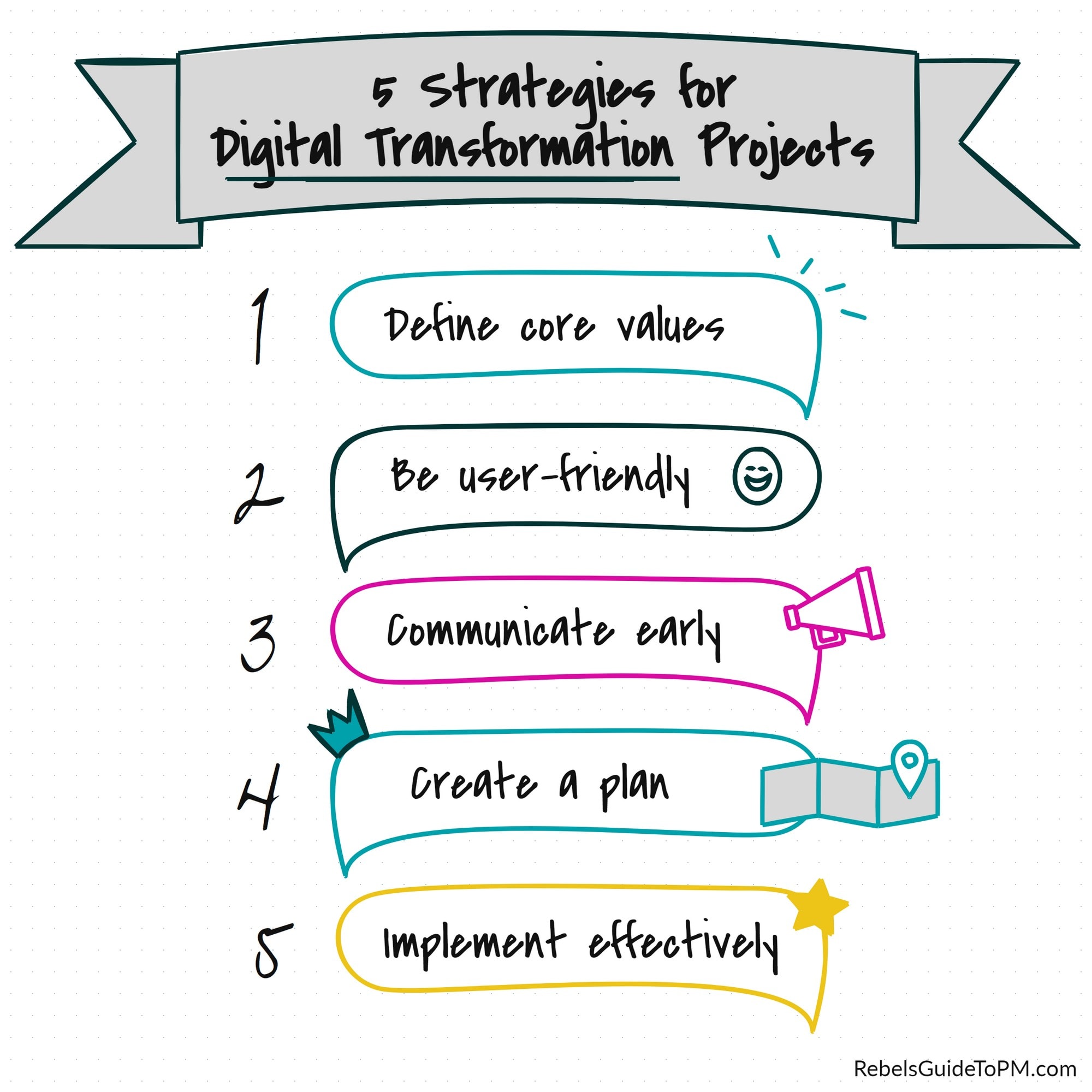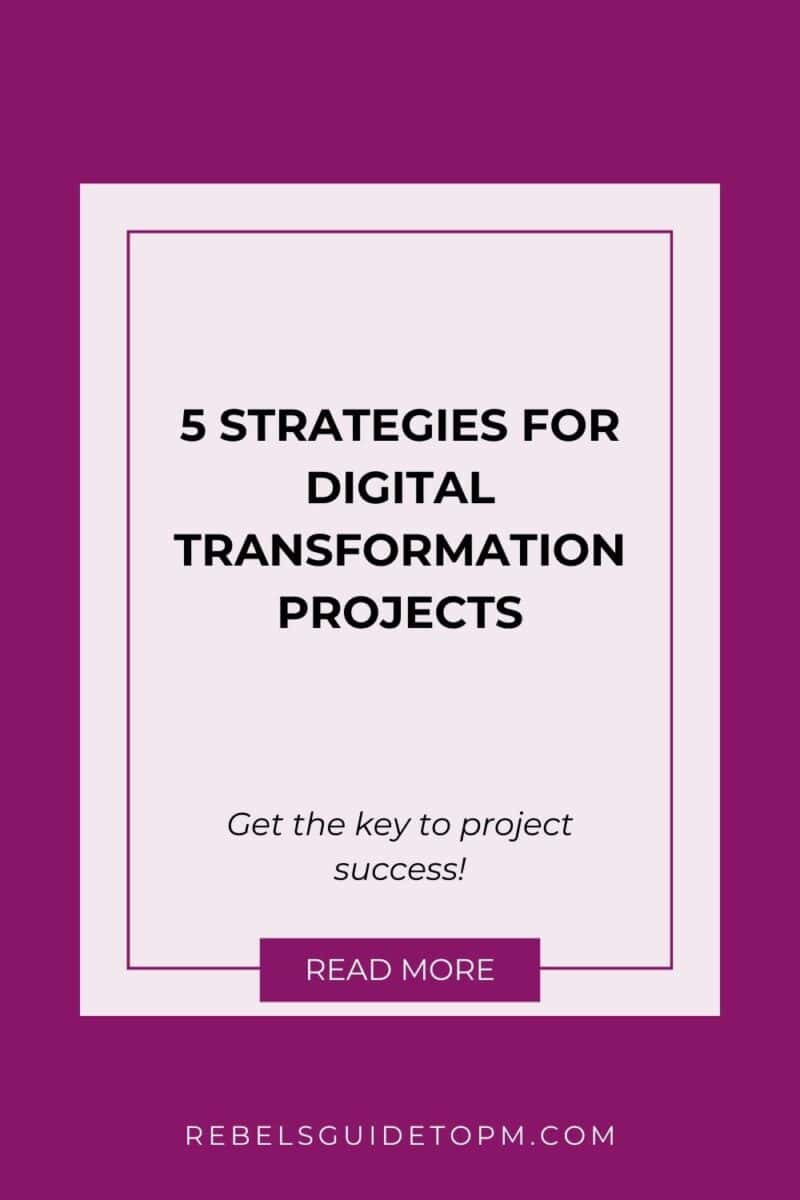5 Strategies for Digital Transformation Projects
Digital transformation is on the rise. Microsoft predicts that every company will become a tech company. PMI predicts that nearly half of companies will be using AI by 2026, and that’s not the only AI statistic that shows this is a trend that isn’t stopping.
Many organizations are looking for ways to digitally enable their businesses – often through new technologies – in order to improve performance or gain a competitive advantage.
As a project manager, you will likely find yourself working on one of such projects such as implementing a new CRM system, upgrading to a cloud-based ERP, or developing a new eCommerce platform.

But many digital transformation projects fail because organizations begin these initiatives without a clear idea of what they want to achieve. This lack of planning often leads to projects going over budget and not achieving their goals.
The objective of using technology in business should always be to somehow enhance the process or outcome, whether that means establishing better customer relations, automating operations, or boosting sales.
Defining your objectives for a digital transformation project is key to success. You also need to understand strategies that work before you begin so you can hit the ground running and avoid unnecessary delays or setbacks.
In this blog post, we will discuss five key strategies for digital transformation projects. Let’s get started!
What are the 5 key strategies for digital transformation projects?
Trends in project management have highlighted that digital transformation is here to stay. If you are about to begin working on a transformation initiative, what should you consider?
Here are 5 key strategies for achieving success on your digital transformation project.
1. Define your business core values
Digital technology is critical for businesses today – it can help you reach new markets, discover new business opportunities, and improve your products and services. But technology also brings with it a host of challenges, particularly when it comes to digital transformation.
In a rapidly changing world, every organization needs a clear set of core values that everyone in the organization can follow. A strategic organization must have a purpose, a vision, a mission and a set of core values that define its actions to reach those goals.
When using digital technologies to create new or different business processes, products, and services, you need to consider the impact of those changes on your business reputation and employees.
Here are some things to consider during your strategy planning meeting. Use these pointers to clarify your business’ core values and your company mission and vision, so your project approach aligns to what the organization is trying to do.
- What is your company’s mission?
- What do you want to achieve?
- What are your company’s guiding principles?
- What return on investment are you expecting?
- How can you ensure that everyone is aligned with your core values?
Answering these questions will help you make sure that your project is aligned with your company’s mission. It will also help you communicate better with your team and build buy-in for the project.
As business transformation and digital technology continue to evolve, it’s important for businesses to clarify their core values. Defining these values early on will help ensure that everyone is on the same page and working towards the same goals.
When you have a clear understanding of your business’ core values, you can start to develop a project management strategy that is in line with these values. Why not use innovative tech to support the way you implement the change as well: AI in project management is a growing field so you can test out new ways of working.

2. Develop a user-friendly system that incorporates effective technologies
You need to be open-minded to change a business. Look at how different techniques and systems could provide better solutions. With digital-first strategies rapidly advancing, it is easy to take advantage of different technology solutions to underpin the cultural transformation as well.
84% of the top companies say the cloud provides a competitive advantage. The cloud has changed the way we interact with data, making it possible to store and process huge amounts of information. Apps and computer systems now give us new ways to analyze and make use of this data.
Project managers must be able to identify and utilize the best digital tools to drive data-driven decision-making and improve customer experience. Look at machine learning, robotic process automation and digital services to fuel your digital transformation goals.
By developing a user-friendly system that incorporates effective technologies, businesses can streamline their processes and reduce costs. In today’s ever-changing business landscape, this can give your business the edge it needs to succeed.
3. Start communication early
Maintaining excellent employee morale is essential for every organization going through a digital transformation. Frequent communication and opportunities for growth will keep everyone on the project feeling motivated and support the company culture to shift to where it needs to be.
Define your project communications approach to ensure that you can communicate early and often when changes are happening in your company. As a project leader, it is important to be transparent and use language that everyone can understand. Make sure to keep the lines of communication open at all times and provide training if necessary.
Early user experiences will shape the later stages of your digital transformation investment, so you’ll want to bring in digital adoption managers and individual employees to share their experiences of the new journeys and the training support they had.
As the transformation process moves forward, keep your team updated with success stories. If certain objectives aren’t being met, be transparent about how the standard plans are changing to better fit the company’s needs.
Even after you have completed your implementation, it is important to maintain a central communications hub, for example a repository of digital content such as user guides or newsletters.
4. Develop a SMART project plan
A successful project plan is essential for any digital transformation jourrney. Your plan should be specific, realistic, achievable, and measurable so you can track progress. It should also be flexible enough to accommodate changes that will inevitably occur during the course of the project.
When project managers develop a clear and concise outline of the goals and objectives of the project, it is easy to identify the business processes that will be affected by the transformation, and this should be identified and analyzed.
You will need to work closely with team members and business processes to ensure that the project plan is followed and that the transformation is successful. This may require making changes to the project plan as the project progresses.
However, by developing a successful project plan, you can increase the chances of a successful digital transformation and ensure that your team is able to execute the business strategy effectively.
TRIP prioritization
TRIP is a prioritization method for digital transformation projects. It stands for:
- Transparency
- Responsiveness
- Intelligence
- Personalization
TRIP analysis is a way of looking at where you are now and where you want to be in those criteria. Then you use those insights to rank initiatives within the transformation work.
Transparency and intelligence are driven by the organization, so you get to decide how you wish to respond.
Responsiveness and personalization are external forces around how you respond to the market and new expectations. It’s really about organizational competitiveness and it’s a piece of thinking to do that might frame the strategic context for your prioritization efforts for digital transformation efforts.
5. Outline the steps for implementation
It’s time to start thinking about implementation once you have a solid plan in place. Outline the necessary steps for implementation to ensure that the project stays on track and doesn’t get bogged down in details. These might include:
Use data analytics and artificial intelligence to improve your systems and evaluate new opportunities. Once potential opportunities for improvement are identified, these become the primary objectives of the transformation.
Understand stakeholders’ objections and fears as they come up, and work through them. Help people see that the transformation plan is sound and that the results support the business models in use. You can do this by pointing out areas of pain and places where things can be improved for the business.
Build digital skills across the organization and build the employee experience into the way you choose to roll out tech changes.
Automate internal processes that are causing difficulties, by using online storage and tools to create standardization. For example, you can use cloud-based tools with built-in alerts and workflows that can be used to automate processes.
Create alignment between team member goals and business goals. Everybody on the team should know how their own skills can help the organization to be successful. This is what makes people feel connected to a project.
Why is agile methodology important in a digital transformation project?
Digital transformation means incorporating technology-driven ways of working into areas of the organization that previously didn’t rely on tech. That shift towards tech-enabled processes leads to changes in how companies engage customers and clients and how business operations are led and managed.
These new approaches are more responsive to changes in technology and provide communications and process management tools that allow us to coordinate far more people and activities than we ever used to be able to.
As a project leader on such a project, you have the responsibility to make decisions that support your organization’s goals and help your team get the work done by stepping into the role of a strategic adviser or coach.
In order to move away from the status quo towards the new operating model, companies must become comfortable with making mistakes and experimenting, however uncomfortable that might feel.
This is why the best project management framework to use for a digital transformation initiative is an agile method, but of course make the decision based on what works for your organization.
Agile methodologies follow an iterative and incremental approach that emphasizes close collaboration between cross-functional teams, rapid delivery of value, and continual learning. Some other benefits of using
- Increased transparency and communication between team members and business leaders
- The ability to rapidly experiment and learn from failures
- Increased customer engagement and feedback
- A focus on delivering business outcomes and value early
- New innovations and ways of thinking.
Digital transformation is a challenge for any organization, but
What is a digital transformation strategy?
A digital transformation strategy is a plan that helps organizations to change how they use and deliver digital technologies in order to improve performance. It provides a clear roadmap for the project, which can be used as a reference point throughout the duration of the project.
A successful transformation strategy will take into account an organization’s current state, its desired future state, and the gaps in between. In order to create a strategy that will be successful, organizations need to first understand what digital transformation is and why it is important.
Additionally, it is essential to involve all stakeholders in the strategy development process, from the C-suite to front-line employees. Only by taking all of these factors into account can organizations develop a digital transformation strategy that will help them to achieve their desired outcomes.

Key takeaways
Companies must embrace digital transformation projects in order to survive in today’s digital age. This involves automating processes and using technology to improve business efficiency.
Technology is ever-changing, and it can be difficult for companies to keep up. As a manager, your project leadership skills, business objectives, and your ability to relate to your team will be the driving force behind any
By starting communication early, developing a successful project plan, and outlining the necessary steps for implementation, you can increase the chances of a successful digital transformation.
Keep the lines of communication open at all times, provide training if necessary, and maintain a central communications hub even after the transformation is complete. By following these steps, you can maximize the chances of delivering your project successfully.
Since change is inevitable, be prepared for it at all times. This means being able to adapt as a project manager when changes such as digital transformation happen. Most times these changes require strategic decisions based on new requirements of the project. Having this mindset is key to succeeding in any digital transformation project.
This article has been refreshed, updated and edited since it was first published.
